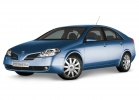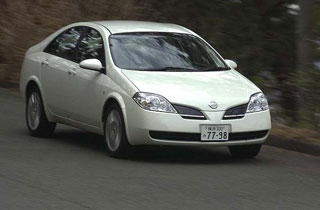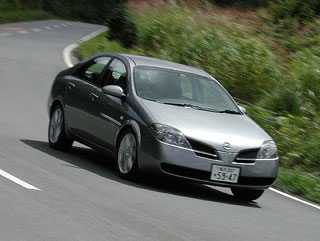Test drive Nissan Primera sedan since 2002 sedan
The main weapon
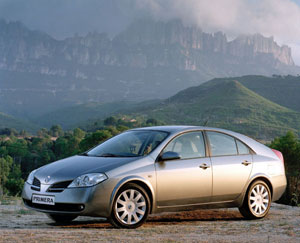 The expression Japanese design was once like a shameful stigma on the forehead of Japanese automakers. High -quality, reliable machines, modern design, advanced technologies but there is no person, familiarity. This was especially true for Toyota and Nissan. The Japanese finally got charges of stylistic failure. Toyota gave birth to a Yarisov style, then the line of Nissan came. The first step was X-Trail, now here is the new Primera.
The expression Japanese design was once like a shameful stigma on the forehead of Japanese automakers. High -quality, reliable machines, modern design, advanced technologies but there is no person, familiarity. This was especially true for Toyota and Nissan. The Japanese finally got charges of stylistic failure. Toyota gave birth to a Yarisov style, then the line of Nissan came. The first step was X-Trail, now here is the new Primera. For the first time, the audience saw the appearance of the new Primera in the fall of 2000 in Paris there the car acted as the Nissan Fusion concept. The disguise for the concept was a slight deception, because by that time the project of the serial machine was already ready for a year. And for sure, soon a new sedan and station wagon debuted in Japan, intended for those who are a step ahead of their time ...
To create European versions of Primera, it took an additional time the car should be finalized for local requirements and tastes, since about 80% of all the machines collected at the plant (Great Britain) is supposed to export to the continent. And this is about 100 thousand cars a year. The company entrusts the new Primera high hopes, hoping to significantly increase its share in the European sector of the D-class car market (it includes Ford Mondeo, Volkswagen Passat and Opel Vectra).
Primera of the previous generation with a 1990 model’s platform also had a European origin and lasted on the conveyor for more than five years (since 1996), although with a thorough restyling in 1999. With all its advantages, the car had a serious flaw boring appearance. You can’t say this about the new Primera. When creating it, the company abandoned its previous Less-Si-More approach. Sayonara ...
Here is what Stefan Schwartz said, the chief designer of the Nissan European Studio, representing the Fusion concept in Paris: imagine a regular, well-known car, but covered with a thick layer of snow. See how the snow softens, smooths out lines, distorts the usual forms. That is what we tried to do with Fusion. It would seem that it can be more familiar and ordinary than the sedan. But we challenged these orthodox views ... The new Primera was presented in December 2001, without waiting for the beginning of serial production. The pre -production samples of the sedan and the station wagon were rolled out onto the test, there was no hatchback. The country was chosen warmer by Spain. Barcelona, \u200b\u200btemperature plus fifteen, you can’t imagine a cloudless sky better ...
The design of the new Primera is really extraordinary, although you can’t call it revolutionary. The body is solved in the current style of sharp edges, formed by the intersection of the correct surfaces of great curvature. It would seem that you can still come up with after Ford and Audi? But Nissan designers have worked well. Due to the large angles of inclination of the surfaces of the hood and trunk, the Primera silhouette is similar to the pyramid, which is emphasized by the trapezoid -shaped underflow. You can recognize the sedan only by lanterns, it is very similar to the hatchback edge of the rear window practically outputs on the edge of the trunk. In general, there is something mini-wene, mono-comprehensive in this machine. Also, it should be noted, a sign of time, just look at Peugeot 307, Honda Civic, Toyota Corolla.
Is the new Primera is beautiful to say, but the look attracts for sure. I liked the station wagon more: more elegant than a sedan, more dynamic and squat almost a sports car. Plus cast 17-inch wheels shod in the 215th rubber. I started with him.
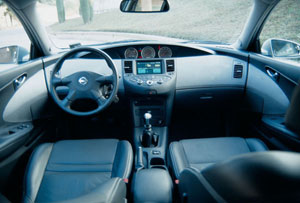 Inside, the car is no less original than outside. Brave sweeping lines, vast surfaces, a deep front panel, smoothly turning into the door. The cabin is almost black. The seats, the steering wheel and armrests are sheathed with expensive vinyl with white stitching. It looks rich. But the plastic is hard, sonorous saved. All devices under a common visor are located in the center. Under them is a large full-color liquid crystalline display, on which the data of the on-board computer, information about the work of music, ventilation and navigation systems, as well as a picture (black and white) from the rear view camera are displayed. Against such a background, a faded yellowish backlight is somehow lost. The control panel of all this, unlike the usual console, is located almost horizontally the hand lies like on the computer keyboard.
Inside, the car is no less original than outside. Brave sweeping lines, vast surfaces, a deep front panel, smoothly turning into the door. The cabin is almost black. The seats, the steering wheel and armrests are sheathed with expensive vinyl with white stitching. It looks rich. But the plastic is hard, sonorous saved. All devices under a common visor are located in the center. Under them is a large full-color liquid crystalline display, on which the data of the on-board computer, information about the work of music, ventilation and navigation systems, as well as a picture (black and white) from the rear view camera are displayed. Against such a background, a faded yellowish backlight is somehow lost. The control panel of all this, unlike the usual console, is located almost horizontally the hand lies like on the computer keyboard. The control scheme is convenient and understandable to the remote control into four zones: audio, navigation, climate control and multifunctional buttons. The main governing bodies on the spot. The seat is completely electric, with a lumbar subpoor. Planting, even when it is lowered to the stop, is high (again, like in a mini-van). The steering wheel seemed too thin in the cross section, the column is adjusted in the corner (the range is small) and in length. The steering wheel switches are made in Japanese: it is controlled by all lighting equipment to the left, on the right wipers. The armrest could be higher.
There are plenty of space space in the second row, even if the front seats are shifted as much as possible; The vertical space is also enough, but the third here is clearly superfluous.
The lid of the trunk is unlocked from a separate button of the remote control. A lot of closed boxes. Under the floor, a removable trough, under it, a palm trailer, is even lower than a full -size reserve. The curtain and mesh are twisted into one removable box. On the back of the trunk cover, convenient handles for closing, in the sedan for some reason they were considered excess. All doors are closed easily and unambiguously.
I got a station wagon with a 2 l 140-horsepower engine and six-speed mechanics. On the idle, the motor reminds of itself with barely noticeable vibrations on the floor and lever of the box. The dynamics are expected, even, with a slight pickup after 4000 rpm. The sixster is, of course, cool, but on a station wagon with 2 liters of engine, it, in my opinion, is not too appropriate. The programs are short, and you have to sort them out quite often. Family shed for a hot driver ...
The selectivity is not bad, although several times instead of the sixth turned on the fourth. Two liters of the motor were quite enough both in the city and outside it. The fifth gear can be pulled from 50 km/h.
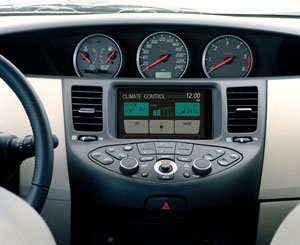 A sedan with a 2-liter engine from the station wagon on the go is practically no different. A car with a 1.8-liter engine does not very much lose to him, however, it will be worse. This is especially noticeable on the highway after 150 km/h the decibels are already annoying. And with a five-speed box is somehow comfortable.
A sedan with a 2-liter engine from the station wagon on the go is practically no different. A car with a 1.8-liter engine does not very much lose to him, however, it will be worse. This is especially noticeable on the highway after 150 km/h the decibels are already annoying. And with a five-speed box is somehow comfortable. The sedan with 2 liters of the engine and the variator is more interesting, with the possibility of forced choice of one of the six fixed gears. In automatic switching mode, they occur faster than in most machines. But in some cases (for example, after setting the desired speed, followed by its maintenance), when the machine would cross the step above, the variator hangs. And everything would be fine if the engine did not begin to strain the engine at a speed above 4000, asking for mercy. Some extraneous sounds are also mixed, as if a clutch slips. However, this is easy to correct by using the manual regime. And, of course, the ratio of speed (dynamics) and engine speed, characteristic of machines with a variator, is unusual.
On Primera with a 126-horsepower 2.2 liter turbodiesel, a 6-speed box is also placed. This is generally incomprehensible to the traction diesel and 4-speed. In addition, two things were remembered: noisy and shaking. It is hoped that these are only a pre -production model. There is also a modification of a machine with a 1.6-liter engine, but it was not on the test, universal joy. And in Russia it will hardly be popular.
Cherry without revelations. A little harsh, and the rolls could be smaller. The beginning of the sliding is quite predictable, and therefore it is easy to fight it. Primera's straightforward trajectory holds confidently almost to the maximum speed. The steering wheel is heavy, you can’t twist it with one finger with one finger, but it has a decent reactive effect at speed. Left quite pleasant impressions and movement on mountain serpentines.
Brakes also do not require any surprises without surprises. ABS makes it possible to show driver skills, and if something delicately helps. Vibro- and soundproofing of the salon at a decent level. Aerodynamic noises stand out from 120 km/h.
Review. External mirrors are small. And I would also like to observe the front of the hood to observe the front dimensions from the haste at all. Even resting his head on the ceiling, it is still not visible. Admire the embossed hood outside.
Now about the bells and whistles. First of all, a very useful thing is a navigation system. She will show everything and even tell a pleasant female voice. If he made a mistake in choosing a path another and leads to a cherished goal. It will warn in advance about the need to refuel the car and indicate where. If you need to refuel the driver too. The system will report traffic jams, temperature overboard, upcoming ice. In short, it will take care of you like a mother. But not with us. And not because the satellites do not fly over us, but because it shows the road, and we only have directions.
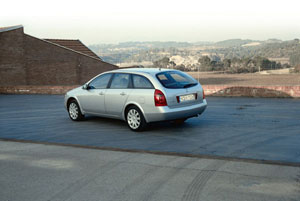 The second lotion is smart cruise control. With the help of an infrared sensor, this system determines and maintains the necessary distance to the in front of the driven car in the speed range you set. Speed \u200b\u200band distance are maintained by engine control, and, if necessary, brakes. The future of such a miracle of technology on our roads is also vaguely ambiguous by the outcome of his struggle against Russian rudeness. The system will probably come from the brains from suddenly appearing and endangered objects in front of the front bumper. In addition, it is likely that you are CT
The second lotion is smart cruise control. With the help of an infrared sensor, this system determines and maintains the necessary distance to the in front of the driven car in the speed range you set. Speed \u200b\u200band distance are maintained by engine control, and, if necessary, brakes. The future of such a miracle of technology on our roads is also vaguely ambiguous by the outcome of his struggle against Russian rudeness. The system will probably come from the brains from suddenly appearing and endangered objects in front of the front bumper. In addition, it is likely that you are CT But the rear view digital camera, which automatically turns on when moving back, is a thing useful everywhere. It is located above the rear number and is intended mainly for the visual determination of the distance to the low objects of which is not visible in the mirrors ...
It is impossible to say that Nissan Primera is very ahead of classmates in technical and dynamic indicators. They are high enough for her class more correctly. And therefore it turns out that the extraordinary appearance of the main weapon of the new Primera in the European market.
Production in Sanderland began on December 17, 2001. The first assembled car sedan color of cannon metal went to Italy. But his potential buyer, like the Russians, will have to wait on March 1 by the official start of sales.
Sergey Yakubov
Source: Motor magazine [March 2002]
Video Crash tests Nissan Primera sedan since 2002
Nissan Primera Sedan tests since 2002
Nissan Primera Crash Test sedan since 2002
Krassh Test: Detailed Information29%
Driver and passengers
9%
Pedestrians
Nissan Primera malfunctions since 2002
Nissan Primera Sedan malfunctions: Detailed information| Primera sedan since 2002 | |
|---|---|
| Engine |  |
| Transmission |  |
| Control system and suspension |  |
| Brake system |  |
| Air heating and air conditioning |  |
| Launch and charging system |  |
| Electric components and so on |  |
| Corrosion body stability |  |


